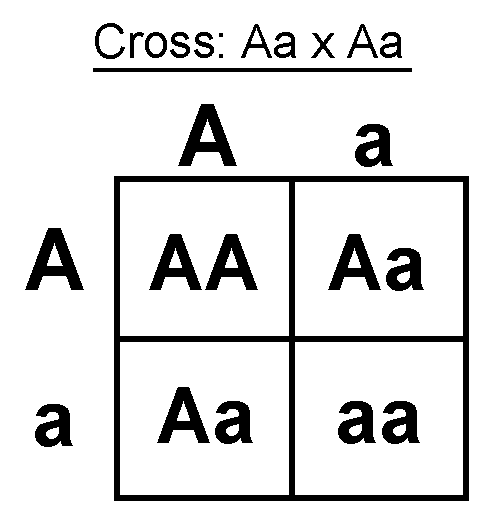Mathematical rules that govern probability are required to determine the chance of certain traits and characteristics. PROBABILITY IS DEFINED AS THE POSSIBILITY THAT AN OUTCOME WILL OCCUR IF ITS A MATTER OF CHANCE.
Likelihood of an outcome is predicted on a scale of 0 to 1.
- Outcome certain to occur = 1
- Outcome not possible to occur = 0
- Product rule
- When 2 or more events are independent, the probability that they will occur is calculated by the product rule
- Individual probabilities are multiplied
- Probability events A and B will occur = Prob A x Prob B
- Sum Rule
- Applies when several different events all give the same outcome
- Probability that either event A or event B or C will occur = Prob A + Prob B + Prob C
Punnett-square method used to determine the genotypes of offspring and their expected proportions.
To use Punnett Square:
- Write the probability that meiosis will produce gametes with each type of allele from one parent at the top of the diagram
- Write the chance of obtaining each type of allele from the other parent on the other side
- Fill in the cells by combining the alleles from the top and left of the square and multiplying their individual probabilities
- If the offspring of testcross are of two types (produces gametes) with half with dominant trait and the other half with recessive trait, then it is a heterozygote
- If all offspring display the dominant trait, then it is a homozygote
MENDEL'S PRINCIPLE OF INDEPENDENT ASSORTMENT:
"The alleles of the genes that govern the two characters separate independently during the formation of gametes"
SUTTON'S CHROMOSOME THEORY
He discovered:
- Chromosomes occur in pairs in sexually reproducing diploid organisms as do alleles of each gene
- Chromosomes of each pair are separated and delivered singly to gametes as are the alleles of a gene
- Separation of any pair of chromosomes in meiosis and gamete formation is independent of the separation of other pairs as in independent assortment of alleles of different genes in Mendel's dihydrid cross
- One member of each chromosome pair is from one male parent and other from the female parent, in an exact parallel with two alleles of a gene
The particular site on a chromosome where gene is located is called LOCUS OF GENE. The locus is a particular DNA sequence that encodes a protein or ribonucleic acid (RNA) product responsible for the phenotype controlled by the gene.
At the molecular level, different alleles consist of small differences in the DNA sequence of the gene which may result in the functional differences in proteins or RNA product encoded by the gene. The differences can be detected as distinct phenotypes in the offspring of the cross.


No comments:
Post a Comment